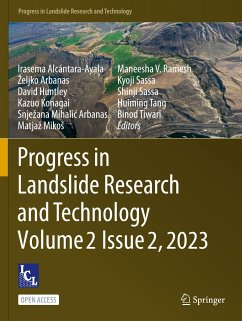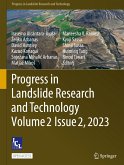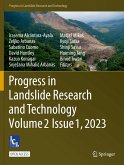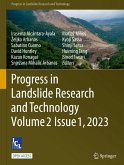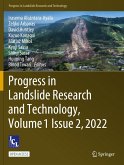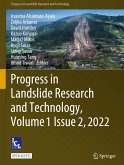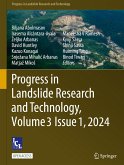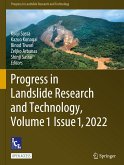Progress in Landslide Research and Technology, Volume 2 Issue 2, 2023
Herausgegeben:Alcántara-Ayala, Irasema; Arbanas, Zeljko; Huntley, David; Konagai, Kazuo; Mihalic Arbanas, Snjezana; Mikos, Matjaz; V. Ramesh, Maneesha; Sassa, Kyoji; Sassa, Shinji; Tang, Huiming; Tiwari,
Progress in Landslide Research and Technology, Volume 2 Issue 2, 2023
Herausgegeben:Alcántara-Ayala, Irasema; Arbanas, Zeljko; Huntley, David; Konagai, Kazuo; Mihalic Arbanas, Snjezana; Mikos, Matjaz; V. Ramesh, Maneesha; Sassa, Kyoji; Sassa, Shinji; Tang, Huiming; Tiwari,
- Broschiertes Buch
- Merkliste
- Auf die Merkliste
- Bewerten Bewerten
- Teilen
- Produkt teilen
- Produkterinnerung
- Produkterinnerung
This open access book provides an overview of the progress in landslide research and technology and is part of a book series of the International Consortium on Landslides (ICL). The book provides a common platform for the publication of recent progress in landslide research and technology for practical applications and the benefit for the society contributing to the Kyoto Landslide Commitment 2020, which is expected to continue up to 2030 and even beyond to globally promote the understanding and reduction of landslide disaster risk, as well as to address the 2030 Agenda Sustainable Development Goals. …mehr
Andere Kunden interessierten sich auch für
![Progress in Landslide Research and Technology, Volume 2 Issue 2, 2023 Progress in Landslide Research and Technology, Volume 2 Issue 2, 2023]() Progress in Landslide Research and Technology, Volume 2 Issue 2, 202339,99 €
Progress in Landslide Research and Technology, Volume 2 Issue 2, 202339,99 €![Progress in Landslide Research and Technology, Volume 2 Issue 1, 2023 Progress in Landslide Research and Technology, Volume 2 Issue 1, 2023]() Progress in Landslide Research and Technology, Volume 2 Issue 1, 202342,79 €
Progress in Landslide Research and Technology, Volume 2 Issue 1, 202342,79 €![Progress in Landslide Research and Technology, Volume 2 Issue 1, 2023 Progress in Landslide Research and Technology, Volume 2 Issue 1, 2023]() Progress in Landslide Research and Technology, Volume 2 Issue 1, 202339,99 €
Progress in Landslide Research and Technology, Volume 2 Issue 1, 202339,99 €![Progress in Landslide Research and Technology, Volume 1 Issue 2, 2022 Progress in Landslide Research and Technology, Volume 1 Issue 2, 2022]() Progress in Landslide Research and Technology, Volume 1 Issue 2, 202233,99 €
Progress in Landslide Research and Technology, Volume 1 Issue 2, 202233,99 €![Progress in Landslide Research and Technology, Volume 1 Issue 2, 2022 Progress in Landslide Research and Technology, Volume 1 Issue 2, 2022]() Progress in Landslide Research and Technology, Volume 1 Issue 2, 202241,99 €
Progress in Landslide Research and Technology, Volume 1 Issue 2, 202241,99 €![Progress in Landslide Research and Technology, Volume 3 Issue 1, 2024 Progress in Landslide Research and Technology, Volume 3 Issue 1, 2024]() Progress in Landslide Research and Technology, Volume 3 Issue 1, 202440,99 €
Progress in Landslide Research and Technology, Volume 3 Issue 1, 202440,99 €![Progress in Landslide Research and Technology, Volume 1 Issue 1, 2022 Progress in Landslide Research and Technology, Volume 1 Issue 1, 2022]() Progress in Landslide Research and Technology, Volume 1 Issue 1, 202242,99 €
Progress in Landslide Research and Technology, Volume 1 Issue 1, 202242,99 €-
-
-
This open access book provides an overview of the progress in landslide research and technology and is part of a book series of the International Consortium on Landslides (ICL). The book provides a common platform for the publication of recent progress in landslide research and technology for practical applications and the benefit for the society contributing to the Kyoto Landslide Commitment 2020, which is expected to continue up to 2030 and even beyond to globally promote the understanding and reduction of landslide disaster risk, as well as to address the 2030 Agenda Sustainable Development Goals.
Produktdetails
- Produktdetails
- Progress in Landslide Research and Technology
- Verlag: International Consortium on Landslides / Springer / Springer Nature Switzerland / Springer, Berlin
- Artikelnr. des Verlages: 978-3-031-44298-8
- 1st ed. 2023
- Seitenzahl: 520
- Erscheinungstermin: 29. Dezember 2023
- Englisch
- Abmessung: 279mm x 210mm x 28mm
- Gewicht: 1253g
- ISBN-13: 9783031442988
- ISBN-10: 3031442989
- Artikelnr.: 68612049
- Herstellerkennzeichnung Die Herstellerinformationen sind derzeit nicht verfügbar.
- Progress in Landslide Research and Technology
- Verlag: International Consortium on Landslides / Springer / Springer Nature Switzerland / Springer, Berlin
- Artikelnr. des Verlages: 978-3-031-44298-8
- 1st ed. 2023
- Seitenzahl: 520
- Erscheinungstermin: 29. Dezember 2023
- Englisch
- Abmessung: 279mm x 210mm x 28mm
- Gewicht: 1253g
- ISBN-13: 9783031442988
- ISBN-10: 3031442989
- Artikelnr.: 68612049
- Herstellerkennzeichnung Die Herstellerinformationen sind derzeit nicht verfügbar.
Prof. Irasema Alcántara-Ayala is a former Director and current Professor at the Institute of Geography of the National Autonomous University of Mexico (UNAM). She is a member of the UNDRR R-STAG of the Americas and an Editor of the ICL book series P-LRT. Prof. eljko Arbanas is the Vice President of the ICL for Europe. He is a professor at the Faculty of Engineering, University of Rijeka, Croatia. He is an Assistant Editor-in-Chief of the International Journal Landslides and the ICL book series P-LRT. Dr. David Huntley is Research Scientist with the Geological Survey of Canada and Open Learning Faculty at Thompson Rivers University, British Columbia. He is an Editor of the ICL book series P-LRT. Prof. Kazuo Konagai is a Professor Emeritus at the University of Tokyo and Principal Researcher of the ICL headquarters. He is an Assistant Editor-in-Chief of the ICL book series P-LRT. Prof. Snjeana Mihali¿ Arbanas a Professor of the Faculty of Mining, Geology and Petroleum, University of Zagreb in Croatia. She is the Chair of ICL Network Committee. Matja Miko, Professor at the Faculty of Civil and Geodetic Engineering, University of Ljubljana, Slovenia, is the Chairman of the Global Promotion Committee of the International Programme on Landslides and Kyoto Landslide Commitment 2020. Dr. Maneesha Vinodini Ramesh is the Provost of Amrita Vishwa Vidyapeetham, Dean, School for Sustainable Development, Director, AMRITA Center for Wireless Networks & Applications, Amrita Vishwa Vidyapeetham, India. She is an Editor of the ICL book series P-LRT. Prof. Kyoji Sassa is the Founding President and the Secretary General of the ICL and the Secretary General of the Kyoto Landslide Commitment 2020. He is the Editor-in-Chief of the International Journal Landslides and the ICL book series P-LRT. Dr. Shinji Sassa is the Head of Soil Dynamics Group and Research Director at Port and Airport Research Institute, National Institute of Maritime, Port and Aviation Technology, Japan. He is an Editor of the International Journal Landslides and the ICL book series P-LRT. Prof. Huiming Tang is the Vice President of China University of Geosciences (Wuhan) and a Chief Professor at the Faculty of Engineering. He is a full member of ICL, Chairman of the Engineering Geology commission of China and Vice President of IAEG. Prof. Binod Tiwari is the Vice President of the ICL for America. He is a professor of civil and environment engineering at the California State University, Fullerton California, USA. He is an Assistant Editor-in-Chief of the ICL book series P-LRT.
Part I: ICL Landslide Lesson.- Advancements in shear strength interpretation, testing, and use for landslide analysis.- Rock Avalanches in the Tibet Plateau of China.- Part II: Original articles.- Landslide Susceptibility Zonation Using GIS-based Frequency Ratio Approach in the Kulon Progo Mountains Area, Indonesia.- Physically-based regional landslide forecasting modelling: model set-up and validation.- Consequence - frequency matrix as a tool to assess landslides risk.- Do not let your guard down: landslide exposure and local awareness in Mexico.- Landslides in Higher Education Curricula and Beyond.- Community Scale Landslide Resilience: A citizen-science approach.- Remedial Measures Impact on Slope Stability and Landslide Occurrence in Small-Scale Slope Physical Model in 1g Conditions.- Surficial geology and geomorphology of the North Slide, Thompson River valley, British Columbia: application of fundamental geoscience information to interpretations of geospatial monitoring results.- High Resolution Numerical Weather Simulation for Orographic Precipitation as an Accurate Early Warning Tool for Landslide Vulnerable Terrains.- Climate Change as Modifier of Landslide Susceptibility: Case Study in Davao Oriental, Philippines.- Fractal-based evaluation of the spatial relationship between conditioning factors and the distribution of landslides (A case study in Tinh Tuc, Cao Bang province, Vietnam).- Procedure of Data Processing for the Improvement of Failure Time of a Landslide Based on the Velocity and Acceleration of the Displacement.- Numerical analysis of the effect of rainfall on the stability of sandstone-covered mudstone cutting slopes.- Part III: Review articles.- Post-formation behaviour of Hattian Landslide Dam and post-breaching situation.- Investigation of debris flow impact mechanisms and designs.- A review of the disaster risk assessment perspectives.- Part IV: IPL/WCOE/KLC2020.- Application of LAND-SUITE for landslide susceptibility modelling using different mapping units. A case study in Croatia.- An Integrated approach to landslides risk management for local and national authorities.- Assessing landslide hazard in the High City of Antananarivo, Madagascar (UNESCO Tentative site).- Part V: ICL Landslide Teaching Tools.- Teaching Tools for LS-Tsnnamis.- Part VI: Technical Notes and Case Studies.- CliRtheRoads - An integrated approach to landslide risk management on roads in Serbia.- Part VII: World Landslide Reports.- Rock slope instabilities affecting the AlUla archaeological sites (KSA).- Refugees' perception of landslide disasters: Insights from the Rohingya camps in Cox's Bazar, Bangladesh.
Part I: ICL Landslide Lesson.- Advancements in shear strength interpretation, testing, and use for landslide analysis.- Rock Avalanches in the Tibet Plateau of China.- Part II: Original articles.- Landslide Susceptibility Zonation Using GIS-based Frequency Ratio Approach in the Kulon Progo Mountains Area, Indonesia.- Physically-based regional landslide forecasting modelling: model set-up and validation.- Consequence - frequency matrix as a tool to assess landslides risk.- Do not let your guard down: landslide exposure and local awareness in Mexico.- Landslides in Higher Education Curricula and Beyond.- Community Scale Landslide Resilience: A citizen-science approach.- Remedial Measures Impact on Slope Stability and Landslide Occurrence in Small-Scale Slope Physical Model in 1g Conditions.- Surficial geology and geomorphology of the North Slide, Thompson River valley, British Columbia: application of fundamental geoscience information to interpretations of geospatial monitoring results.- High Resolution Numerical Weather Simulation for Orographic Precipitation as an Accurate Early Warning Tool for Landslide Vulnerable Terrains.- Climate Change as Modifier of Landslide Susceptibility: Case Study in Davao Oriental, Philippines.- Fractal-based evaluation of the spatial relationship between conditioning factors and the distribution of landslides (A case study in Tinh Tuc, Cao Bang province, Vietnam).- Procedure of Data Processing for the Improvement of Failure Time of a Landslide Based on the Velocity and Acceleration of the Displacement.- Numerical analysis of the effect of rainfall on the stability of sandstone-covered mudstone cutting slopes.- Part III: Review articles.- Post-formation behaviour of Hattian Landslide Dam and post-breaching situation.- Investigation of debris flow impact mechanisms and designs.- A review of the disaster risk assessment perspectives.- Part IV: IPL/WCOE/KLC2020.- Application of LAND-SUITE for landslide susceptibility modelling using different mapping units. A case study in Croatia.- An Integrated approach to landslides risk management for local and national authorities.- Assessing landslide hazard in the High City of Antananarivo, Madagascar (UNESCO Tentative site).- Part V: ICL Landslide Teaching Tools.- Teaching Tools for LS-Tsnnamis.- Part VI: Technical Notes and Case Studies.- CliRtheRoads - An integrated approach to landslide risk management on roads in Serbia.- Part VII: World Landslide Reports.- Rock slope instabilities affecting the AlUla archaeological sites (KSA).- Refugees' perception of landslide disasters: Insights from the Rohingya camps in Cox's Bazar, Bangladesh.

